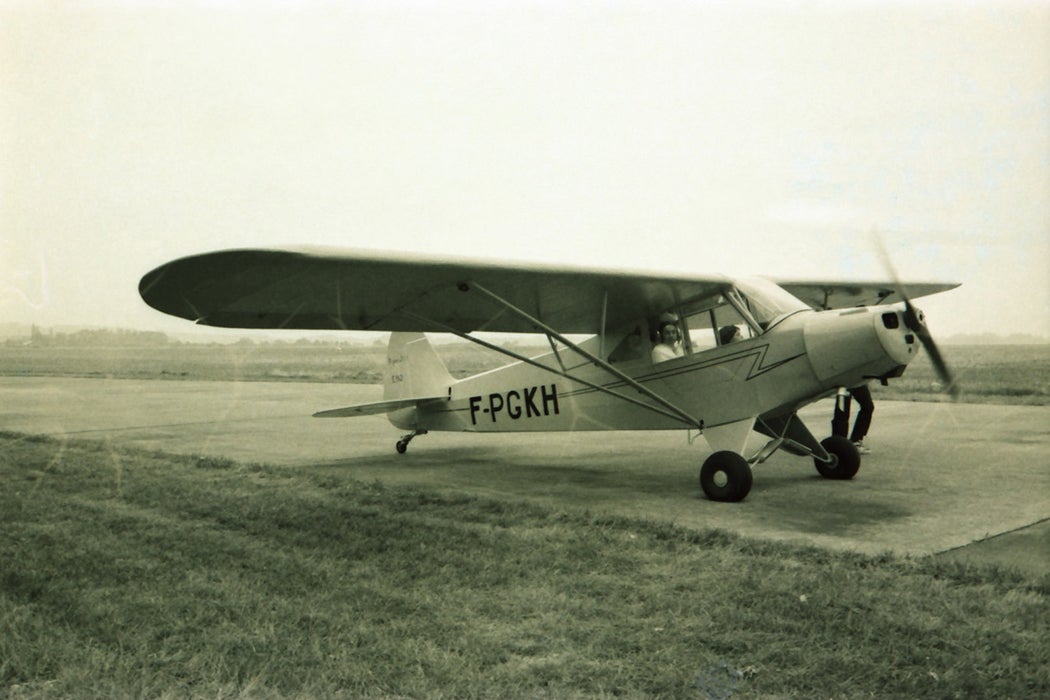Henry Bomhoff probably should have been working on his tractor. It was just a few days before the wheat harvest in the spring of 1935, a tough year to be a farmer on the central Oklahoma plains. Dust storms and drought had already driven many farming families from the region, and wheat prices were plummeting again, but even a meager harvest was a welcome one in the depths of the Great Depression. Instead, though, Bomhoff—Heinie to his neighbors—was working on something unusual in his barn: an airplane constructed from cast-off pieces of farm machinery, a Model A Ford motor, and a D-I-Y kit mail ordered from a mechanics magazine.
“The day my little puddle-jumper was finished I climbed in at once to test the motor and taxi around the wheat field,” Bomhoff said in 1945. “The first thing I knew the tail of the plane was off the ground—then the whole thing took off. There I was in the air without any idea of how to get back on the ground. ”
“I guess I felt a little like the Wright Brothers when they made their first flight,” he reflected years later.
In a way, the comparison was apt. After he managed to land in a neighbor’s field, Bomhoff became known as “the original flying farmer,” whose curiosity and daring marked the beginning of a new, if short-lived, era of agricultural aviation.
Bomhoff patrolled the skies in his homemade plane with a copilot and a shotgun. The already beleaguered Oklahoma farmers were at war with the area’s hungry coyotes, which saw the flocks of turkeys and herds of cattle as a food source. From the cockpit, Bomhoff believed, he could be a better rancher.
Soon, he replaced his makeshift wings with a Piper J-3 Cub, a light aircraft, and began to teach other farmers to fly, including at least 10 men who became U.S. Army pilots in Europe during World War II. Bomhoff was heralded as a “home front hero” in a 1945 syndicated comic strip, which rendered him as a slender, bespectacled man in a newsy cap. “Bomhoff has killed over eight hundred coyotes from the air,” it explained. “By reducing costly livestock and poultry damages, he is helping to relieve wartime food shortages.”
Bomhoff believed that the airplane had even greater potential: It could become the modern farmer’s tractor, an efficient way to herd cattle, survey thousands of acres of cultivated land, spread seeds and pesticides, and transport farm products to far-off places. The war had globalized American agriculture, as farmers sold to Allies around the world. Airplane manufacturers, too, saw a lucrative market; one advertised its planes on the back cover of Prairie Farmer by reminding farmers that, now, no spot on earth was more than 60 hours from the farm.
In 1944, Bomhoff got a visit from H.A. Graham, director of the Agricultural Extension at Oklahoma Agricultural and Mechanical College, and Ferdie Deering, farm editor of Farmer-Stockman magazine. The pair was inviting the state’s air-minded farmers, estimated at about 40, to Stillwater for the first meeting of the Oklahoma Flying Farmers Association. Bomhoff was elected as the group’s leader. The following year, the National Flying Farmers Association was incorporated, and by 1950, membership had grown to some 20,000.
The United States government was equally bullish about agricultural aviation in the post-war era. The Department of Agriculture estimated that 3,000 army planes would become “air trucks,” transporting produce from farm to city, and the Civil Aeronautics Authority encouraged pilots returning from the war to consider life as a flying farmer. “An airplane in every barn?” asked one Midwestern newspaper of the enthusiasm of the late 1940s.
But “the Flying Farmers’ vision of agricultural aviation never materialized,” writes historian Peter Simons. Ultimately, the mid-century enthusiasm could not overcome the economic realities. Owning and maintaining a plane became increasingly costly, distribution channels began to consolidate, and studies showed that spreading seeds and pesticides from the air was inefficient at best. Fewer and fewer farmers were willing to plow under profitable farm land for an air field or to give up their car for wings, as Bomhoff had in 1945. “If I had to let one of them go,” the original flying farmer had professed, ”it would be the car.”







